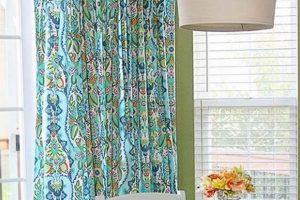Creative apparel customization involves techniques for altering plain garments into personalized fashion statements. These methods encompass fabric painting, stenciling, tie-dyeing, embroidery, heat transfer vinyl application, and the incorporation of various embellishments. For example, an individual may apply a hand-painted design to a cotton tee, transforming a basic item into a unique piece of wearable art.
The practice of customizing apparel offers a cost-effective means of expressing individual style and creativity, providing an alternative to mass-produced fashion. Historically, personalized garments served as a form of self-expression and social commentary. Beyond individual expression, the activity can promote sustainability by upcycling existing clothing, reducing textile waste, and fostering a mindful approach to consumption.
The subsequent sections will explore specific techniques and materials employed in apparel customization, providing guidance on design considerations and execution strategies for achieving personalized and professional-looking results. These techniques span from simple surface design to more complex construction alterations, allowing for a wide range of creative applications.
Effective Apparel Customization Techniques
The following guidelines address essential considerations for successful apparel customization, focusing on achieving durable and visually appealing outcomes.
Tip 1: Fabric Selection. Choose garment materials compatible with the intended customization technique. Natural fibers like cotton are suitable for dyeing and painting, while synthetics may require specialized inks and processes.
Tip 2: Surface Preparation. Pre-wash the garment to remove sizing and ensure proper dye or paint adhesion. Ironing eliminates wrinkles and provides a smooth surface for design application.
Tip 3: Design Planning. Sketch the design beforehand, considering size, placement, and color palette. Templates and stencils can aid in precise execution and consistent results.
Tip 4: Material Compatibility Testing. Conduct a patch test on a hidden area of the garment to assess the interaction between the chosen materials (e.g., paint, ink, vinyl) and the fabric. This prevents unwanted discoloration or damage.
Tip 5: Secure Application. Employ appropriate application techniques for each customization method. For heat transfer vinyl, ensure proper temperature, pressure, and time to bond the material to the fabric effectively.
Tip 6: Layering Techniques. Utilize layering to add depth and dimension to customized apparel. Employ different textures, colors, and embellishments to add visual impact to the design.
Tip 7: Edge Finishing. When using appliqu or fabric cutouts, secure the edges with fabric glue, fusible webbing, or a sewing machine to prevent fraying and maintain design integrity.
Tip 8: Curing and Setting. Following customization, adhere to the manufacturer’s instructions for curing or setting the applied materials. Heat-setting inks and vinyl ensures durability and washability.
Adhering to these guidelines contributes to enhanced aesthetic appeal and longevity of custom apparel. Proper planning and execution are critical for realizing professional-quality outcomes.
The subsequent section explores diverse design concepts and style inspirations for apparel modification, offering a foundation for creative experimentation.
1. Design Conceptualization
Design Conceptualization, in the context of customized apparel, forms the foundational blueprint upon which all subsequent creation processes rely. A coherent and well-defined design serves as the primary determinant of the aesthetic impact and overall success of individualized garments. This phase involves translating abstract ideas into tangible visual representations, ensuring clarity and purpose within the final product.
- Inspiration Sourcing
This aspect entails identifying and synthesizing sources of creative influence. Inspiration can be drawn from diverse areas, including artistic movements, cultural motifs, nature, and personal experiences. For example, an individual might adapt elements from Art Deco for a graphic design or incorporate botanical patterns inspired by local flora. Effective inspiration sourcing results in original and relevant designs.
- Theme Development
Theme development centers on establishing a unifying concept that guides the design’s overall direction. Themes can be abstract or concrete, ranging from social commentary to lighthearted humor. A theme such as environmental awareness might be visually represented through imagery of endangered species or minimalist eco-friendly graphics. A well-defined theme provides a cohesive narrative within the design.
- Composition and Layout
Composition and layout address the strategic arrangement of visual elements within the available space. This facet considers factors such as balance, symmetry, asymmetry, and the rule of thirds to create visual harmony and emphasize key features. Proper composition ensures the design is aesthetically pleasing and effectively communicates its intended message.
- Color Palette Selection
Color palette selection involves choosing a coordinated range of colors that complement the design’s theme and aesthetic. Color choices impact the mood, tone, and overall visual impact. A limited color palette based on analogous colors can create a sense of harmony, while contrasting colors can generate visual interest. Effective color palette selection enhances the design’s overall impact and appeal.
These facets of design conceptualization are inherently intertwined with the success of “diy t shirt ideas”. A strong conceptual foundation enhances the potential for creating visually compelling and personally meaningful customized apparel. Overlooking the importance of design conceptualization often results in disjointed or aesthetically unappealing outcomes, underscoring its pivotal role in the customization process.
2. Material Selection
Material selection exerts a direct and substantial influence on the outcome of personalized apparel modifications. The inherent characteristics of the chosen textile affect the application and adherence of dyes, paints, and embellishments. For example, a high-thread-count cotton shirt will provide a smoother, more receptive surface for detailed screen-printing compared to a loosely woven polyester blend. Incorrect material selection may result in diminished design clarity, poor colorfastness, and reduced overall garment lifespan. The interplay between chosen design application and the receiving material is a crucial determinant of success.
The practical implications of material selection extend to garment comfo
rt and maintenance. A design applied to a breathable, natural fiber will offer a more pleasant wearing experience than a similar design transferred onto a non-breathable synthetic fabric. Further, the selected material will dictate the appropriate cleaning method; intricate designs on delicate fabrics necessitate hand-washing or gentle machine cycles, while simpler designs on durable materials may withstand more rigorous cleaning processes. Consequently, material selection influences not only the aesthetic outcome but also the long-term usability of the customized item.
In summary, informed material selection is indispensable for achieving the intended results in apparel customization. The textile’s composition, weave, and surface properties directly impact the design’s appearance, durability, and the garment’s comfort and care requirements. Ignoring material compatibility can lead to design failures, rendering the customization effort unsuccessful. Therefore, a thorough understanding of fabric characteristics and their interaction with customization techniques is essential for producing high-quality, personalized apparel.
3. Technique Mastery
Technique Mastery represents a critical determinant in the successful realization of apparel customization. The connection between acquired skill and the final product is direct and proportional; greater proficiency translates to enhanced aesthetic quality, durability, and overall professional appearance. For example, an individual lacking mastery of screen-printing may produce designs with uneven ink distribution, blurred edges, or inadequate adhesion to the fabric, resulting in a substandard outcome. Conversely, adept application of the same technique yields crisp lines, consistent color saturation, and lasting resilience to washing and wear. Thus, technique mastery directly dictates the quality and longevity of customized apparel.
The component encompasses a broad spectrum of capabilities, spanning design execution, material manipulation, and the effective utilization of specialized tools and equipment. A well-versed artisan understands the nuances of fabric preparation, ink selection, heat application, and finishing processes. The understanding of technical constraints allows for innovative and efficient problem-solving. Without adequate training, an individual may struggle with tasks such as creating precise stencils, mixing custom ink colors, or calibrating heat presses, potentially leading to project delays, material waste, and unsatisfactory results. An experienced textile artist will not only produce better outcome, but will also work in efficient ways with safety measures.
In conclusion, technique mastery serves as the cornerstone of successful apparel customization, influencing the visual appeal, durability, and overall value of personalized garments. Individuals seeking to engage in apparel customization must prioritize the acquisition of requisite skills and the development of technical expertise. Continuous learning, experimentation, and adherence to best practices are essential for achieving professional-grade results and maximizing creative potential. Ignoring the need for technique mastery leads to avoidable errors and suboptimal outcomes, underscoring the critical importance of this competency in the realm of apparel customization.
4. Application Precision
Application Precision, in the domain of customized apparel, directly influences the quality and longevity of the design. Imprecise application of paints, dyes, vinyl, or other embellishments leads to visual defects, compromised durability, and ultimately, a diminished aesthetic value. Consider a scenario where a heat transfer vinyl design is applied to a garment with uneven pressure. The result is inconsistent adhesion, leading to peeling or cracking after minimal wear. This illustrates the cause-and-effect relationship between application accuracy and the sustained integrity of the personalized item.
The significance of this in apparel customization cannot be overstated. Achieving a professional finish demands meticulous attention to detail, proper alignment, and consistent execution of chosen techniques. For example, when stenciling a design onto a textile, precise placement of the stencil and controlled application of the paint are crucial to prevent bleeding and maintain sharp edges. Similarly, accurate positioning and secure attachment of embellishments, such as beads or sequins, ensure they remain intact through repeated use and laundering. Every technique depends on precision to achieve desired results.
In conclusion, Application Precision is a core component of successful apparel modification. Its absence yields visually flawed and structurally unsound results. Prioritizing precision mitigates risks, enhances the garment’s aesthetic appeal, and increases its lifespan. Recognizing and implementing precise application techniques is, therefore, an indispensable aspect of transforming ordinary garments into unique and enduring personalized creations. Mastering this aspect allows achieving consistent, professional-looking results that reflect the care and attention invested in the process.
5. Durability Enhancement
Durability Enhancement, when directly integrated into apparel customization endeavors, serves as a safeguard against premature wear and degradation, directly impacting the long-term viability of personalized garments. Without proper consideration for methods that improve resistance to damage, customized designs are susceptible to fading, cracking, peeling, or detachment, negating the effort invested in personalization. For instance, a hand-painted design on a t-shirt, lacking proper sealant application or heat-setting, will quickly lose its vibrancy and detail through routine washing, resulting in an unsatisfactory outcome despite the initial creative effort.
The integration of durability-enhancing techniques within the customization process spans multiple aspects. It begins with careful selection of compatible materials, such as fade-resistant dyes and high-quality heat transfer vinyl. Subsequent stages involve precise application and adherence to recommended curing or setting procedures. For example, thorough heat-pressing of vinyl designs ensures a strong bond between the material and the fabric, preventing peeling. Implementing protective measures, such as washing garments inside out or using mild detergents, prolongs the lifespan of customized designs. In the embroidery sector, stabilizing fabric with appropriate backing prevents stitch distortion, while reinforced seams improve the design’s ability to withstand strain.
The strategic focus on Durability Enhancement yields practical benefits for creators and consumers alike. It reduces the need for frequent replacements, fostering a more sustainable approach to clothing consumption. It protects the investment of time and resources made in customizing apparel. It also ensures personalized items maintain their aesthetic appeal over extended use. Overlooking this critical component compromises the integrity of customized garments, ultimately undermining the creativity and effort invested in their personalization. A commitment to improving durability transforms fleeting designs into lasting expressions of
personal style.
6. Style Expression
Style Expression, functioning as the culmination of personalized apparel modification, embodies the intentional conveyance of identity, affiliations, and personal narratives through customized garments. This aspect extends beyond mere aesthetic considerations, serving as a tangible articulation of individual values and creative inclinations. Garments, thereby, function as portable declarations, reflecting the wearer’s unique worldview. Consider the application of bold, geometric patterns inspired by Bauhaus design principles onto a minimalist t-shirt. This act communicates an appreciation for modernism, visual clarity, and functional aesthetics, establishing a direct link between personal taste and wearable art. Failure to effectively integrate style expression undermines the purpose of customized apparel, reducing it to a purely functional object devoid of personal significance.
The influence on garment customization spans a diverse spectrum of methodologies, from direct artistic applications to nuanced modifications. For example, an individual may employ embroidery to subtly incorporate personal monograms or symbolic motifs, communicating a sense of understated elegance and personalization. Alternatively, techniques such as fabric dyeing, bleaching, or distressing may be employed to convey vintage, bohemian, or avant-garde aesthetics. The ability to manipulate visual elements and textual components to evoke specific moods and resonate with particular audiences constitutes a critical aspect of style expression. The strategic implementation of visual language and thematic elements enables individuals to create customized garments that accurately reflect their intended image.
In summary, Style Expression represents the purposeful application of design principles and customization techniques to convey a specific message or aesthetic identity through personalized apparel. Its effective implementation transcends mere ornamentation, transforming garments into authentic extensions of the wearer’s personality. Neglecting the importance of this core aspect limits the potential of customized apparel to achieve its primary goal: facilitating individual expression and visual communication. Therefore, a conscious and deliberate approach to Style Expression is indispensable for realizing the full potential of customized apparel as a medium for self-representation.
Frequently Asked Questions
The following section addresses common inquiries regarding the processes, techniques, and considerations involved in customizing apparel.
Question 1: What are the most durable methods for applying designs to t-shirts?
The durability of a design application is contingent on the method employed. Screen printing generally offers superior longevity compared to heat transfer vinyl, as the ink is directly embedded into the fabric. Embroidery also provides excellent durability, as the design is physically stitched onto the garment. The longevity is closely tied to following specific care instructions.
Question 2: How can one prevent designs applied with heat transfer vinyl from peeling?
Preventing peeling necessitates proper application. Ensure the fabric is pre-washed and wrinkle-free. Use a heat press to apply the vinyl with the correct temperature, pressure, and time settings recommended by the vinyl manufacturer. Allow the design to cool completely before peeling away the carrier sheet. Washing the garment inside out also increases the lifespan of the designs.
Question 3: What type of paint is best suited for fabric painting?
Acrylic paints specifically formulated for textiles offer optimal results. These paints are designed to bond with fabric fibers and withstand repeated washing. Prior to painting, pre-wash the garment to remove sizing and apply a textile medium to the paint to enhance its flexibility and adhesion.
Question 4: How does one avoid dye bleeding when using tie-dye techniques?
To minimize dye bleeding, use fiber-reactive dyes designed for cellulose fibers, such as cotton. Pre-soak the garment in a soda ash solution to prepare it for dyeing. After dyeing, thoroughly rinse the garment in cold water until the water runs clear. Wash the garment separately for the first few washes to remove any residual dye.
Question 5: What factors should one consider when selecting a t-shirt for customization?
Fabric composition, weight, and weave are critical factors. Natural fibers, such as cotton, are generally easier to customize than synthetics. A higher thread count indicates a smoother surface, which is ideal for detailed designs. Consider the garment’s intended use and choose a weight and style appropriate for the application.
Question 6: Is it possible to remove a design from a t-shirt if an error is made?
The feasibility of removing a design depends on the application method and the fabric type. Heat transfer vinyl can sometimes be removed with a heat gun and patience. Paint may be partially removable with specialized solvents, but complete removal is often difficult. In certain situations, it can be more practical to utilize the mistake, and design from that. Prior testing is always recommended.
The answers provided offer a baseline understanding of common challenges and solutions. Further research and experimentation are encouraged for mastering individualized apparel decoration.
The subsequent section presents specific case studies showcasing successful applications of customization techniques.
Conclusion
The preceding exploration of “diy t shirt ideas” has presented a multifaceted overview of apparel customization. Considerations ranging from design conceptualization and material selection to technique mastery, application precision, durability enhancement, and style expression have been addressed. A comprehension of these elements is crucial for achieving desirable outcomes in personalized garment modification.
The deliberate and informed application of these insights promotes both creative expression and the production of durable, aesthetically pleasing, personalized apparel. A continued emphasis on skill development, material research, and meticulous execution will further elevate the potential of individual garment customization. The knowledge shared intends to encourage greater competence and innovation in this field.







